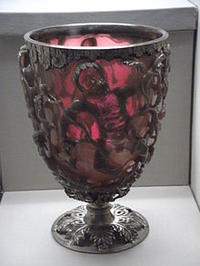Thinking about glass
Did you recognise the beautiful glass vessel in the centre of Miranda's art piece? It's a replica of an Anglo-Saxon Palm Cup (made for us by The Glassmakers). It wouldn't hold much liquid but then, with its curved base, you couldn't put it down until you drained it! What an unusual shape!
Dr Victoria Sainsbury's very brief history of the wine glass

Glass, unlike most materials exploited in the ancient world, is not extracted but synthesised. In fact, vitreous materials are the first truly synthetic materials. Since its discovery, around 5,000 years ago in Mesopotamia, the development of glass had profound impacts on art, personal adornment, food storage, architecture, dining culture and religion. Unlike ceramics or vessels made out of plants, glass does not interact with particularly liquids stored inside it. As well as this, it can hold ‘amorphous’ forms, meaning it can hold practically any shape, and can be easily sealed from the air. All of these qualities have led to the close relationship between glass and wine.
While most of us know that there is a ‘right’ shape of glass for certain types of wine, what many people don’t realise is how recent the ‘typical’ shape of a wine glass is. The shape of the vessels that we use to drink from, particularly intoxicating liquids, is deeply socially informed. Looking at simply the shape of wine glasses, we can learn a great deal about what, when, where and how people are drinking. We can see what elements of the drinking process (colour, smell, portability, spectacle, communality) were given the most priority.
The first glass vessels were highly coloured and made by wrapping glass around a core that was later removed but these were used mostly for the highest value cosmetics and perfumes. These were strongly coloured opaque glasses, very far from anything we would think of as a drinking glass.
Then, around the time of Alexander the Great, glass drinking vessels became a common possession of the elite. Many of these were at least in part transparent, and highly coloured and decorative. Glass rods were twisted together in elaborate patterns, before being cut, fused together in shapes, and slumped over or into moulds to make the shapes of drinking vessels. These are not shapes that we would think of as wine-glasses, but these examples of what archaeologists call ‘vessel glass’ were for wine. Many of these vessels are large, open bowls, which any sommelier would tell you is not ‘ideal’ for an individual to judge bouquet. However, these bowls are a product of their culture, and in particular how Hellenistic Greeks drank wine. These are something for sharing, where a mixture of wine and water was passed between friends and associates. Such wine drinking is not a ‘glass with a meal’, but a social ritual restricted to a small number of elite men.
The invention of glass blowing around the turn of the millennium revolutionised glass vessel production, and the ‘modern’ relationship between glass and wine drinking starts to appear. Glass could be produced in new and daring shapes, leading to exceptional pieces, but it could also be blown into a mould, with an expert producing a vessel in a matter of minutes. Drinking cups, which had been made from either pottery or metal, suddenly began to be produced almost exclusively in this new blown glass. While the Roman’s still mixed their wine with water, they did this in individual cups, rather than en-masse, and the size and shape of vessels decreased, and had more vertical sides.
Colour and Shape
At this same time, the range of colours glassmakers could use changed – not just a wider a range of translucent colours was exploited, but also transparent colours, and for the first time, mass-produced colourless glass.
For the vast majority of early and middle Roman drinking vessels, they are colourless or very lightly coloured. This means that for the first time you could reliably see the colour of your wine. The Roman author Pliny writes extensively about the colour of wine, and like today it was used to assess the region, type and quality of different wines. The number of people who could afford and regularly drink wine greatly increased, as did the market pressures, introducing a greater range of quality. Colour became a vital indicator of type and quality.
Spectacle and display
Most of these glasses are in shape somewhere between a very deep bowl and a beaker. What is more, some of these new wine glasses were designed with either flat-bases or feet, and others with curved bases. While flat-bases seem like an obviously quality for a wineglass, this was not a requirement in the Roman world. In fact, as a general rule of thumb, the better quality a vessel, the less likely it was to be designed to fit on a flat surface. In tavernas and moderate homes, people used tables, so bases were required. However, the Roman elite system of dining was part of an older tradition, where people lay on a sort of couch. Drinking at such events was all part of the show. The very showiest vessels were used, and then handed off to slaves to bear, never having to sit on a table. Several examples have witticisms about drinking included, such as ‘BIBE VIVAS MVLTIS ANNIS’, ‘Drink and you will have long life’.

Lycurgus cup on display, lit from behind, showing the red color effect of the dichroic glass on transmitted light.
Perhaps the most spectacular of such vessels is held in the British Museum. Called the Lycurgus Cup (seen in this picture from Wikipedia by JohnBod), this soft, translucent green cup, is carved with mythological figures. The carving alone would have taken a skilled cutter days to produce, but this cup hides a secret. If it is held up to a source, so light passes through it, it transforms to a bright transparent red. Archaeological scientists have determined that the trick is achieved by a little quirk of colour perception, called structural colour. Minute particles of gold and silver each interact with light differently, scattering it in such a way that it interferes with itself, these interference patterns are perceived by us as colours, the pattern that dominates depending on the conditions. This differs from absorption colouration, how most things are coloured. In these cases a material absorbs a portion of white light that hits it, dependent on its chemistry, and reflects the rest, which we see then as coloured. One can only imagine the effect of such a vessel at a party!
Drinking and Ritual
If you see this vessel now, it has a gold stem and foot. This was added in the medieval period, as it became part of a completely different ritualistic drinking. This cup became a chalice, used to receive communion wine, and because of its divine power had to be possible to be displayed when not in use.
Interestingly, another tradition of wine-drinking that didn’t require sitting began to become popular amongst the general population in Britain. Geramanic drinking traditions using ‘rhytons’, or drinking horns, was an established part of male, particularly military comradery. We see upwardly mobile people swapping out their cow-horns, whose smell is somewhat overpowering next to watered wine, with glass versions. Around the same time, other vessels get less bowl-shaped and more conical, and stop being produced with flat bases or feet. This implies a very different drinking culture. Rather than a cup that can sit on the table while you eat and drink, these cups must be drained every time before being placed down. It is a part of social drinking disassociated from eating.
It is these baseless wine cups that we take into the Anglo-Saxon period. Glass becomes scarcer in Britain, and the drinking vessels continued to change in shape. The long cone-shaped cups slowly get shorter and rounder, moving into the shape of a footless, very small bowl, that nestles in a hand. These are, perhaps not surprisingly, called ‘Palm Cups’. What is perhaps more surprising is that these bowls then elongated out again, into a funnel shape. The problem with all these shapes, from a modern standpoint, is that unless you drink quickly, your wine got warm. However, due to the glass size and style of drinking at the time, this didn't matter.
So rather than 'Bottoms Up!' it should be: 'Bottoms off!'



